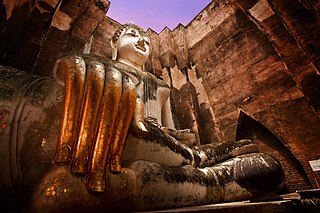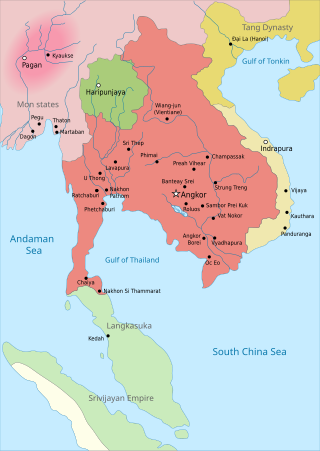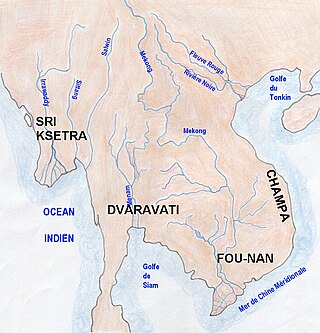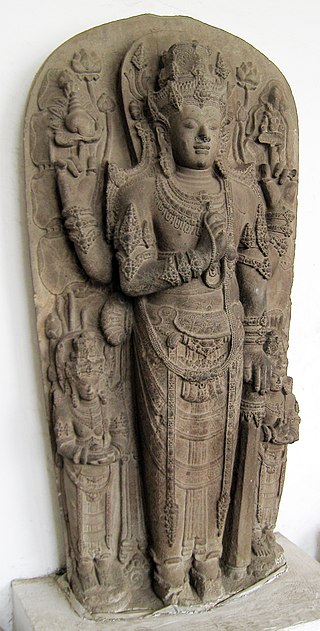Related Research Articles

Angkor, also known as Yasodharapura, was the capital city of the Khmer Empire, located in present-day Cambodia. The city and empire flourished from approximately the 9th to the 15th centuries. The city houses the Angkor Wat, one of Cambodia's most popular tourist attractions.

Sukhothai Historical Park covers the ruins of Sukhothai, literally 'dawn of happiness', capital of the Sukhothai Kingdom in the 13th and 14th centuries, in north central Thailand. It is near the city of Sukhothai, capital of Sukhothai Province.

The Khmer Empire was a Hindu-Buddhist empire in Southeast Asia, centered around hydraulic cities in what is now northern Cambodia. Known as Kambuja by its inhabitants, it grew out of the former civilization of Chenla and lasted from 802 to 1431. Historians call this period of Cambodian history the Angkor period, after the empire's most well-known capital, Angkor. The Khmer Empire ruled or vassalised most of Mainland Southeast Asia and stretched as far north as southern China. At its peak, the empire was larger than the Byzantine Empire, which existed around the same time.

Funan was the name given by Chinese cartographers, geographers and writers to an ancient Indianized state—or, rather a loose network of states (Mandala)—located in mainland Southeast Asia covering parts of present-day Cambodia, Thailand and Vietnam that existed from the first to sixth century CE. The name is found in Chinese historical texts describing the kingdom, and the most extensive descriptions a name the people of Funan gave to their polity. Some scholars argued that ancient Chinese scholars has found the records from Yuán Shǐ, the history records of Yuan Dynasty. "Syam Kok and Lo Hu Kok, formerly the Kingdom of Funan, were located to the west of Linyi Kok. The maritime distance was from the capital of Linyi Kok to the capital of Funan Kok. They are separated by about 3,000 li."

Srivijaya, also spelled Sri Vijaya, was a Buddhist thalassocratic empire based on the island of Sumatra that influenced much of Southeast Asia. Srivijaya was an important centre for the expansion of Buddhism from the 7th to 11th century AD. Srivijaya was the first polity to dominate much of western Maritime Southeast Asia. Due to its location, Srivijaya developed complex technology utilizing maritime resources. In addition, its economy became progressively reliant on the booming trade in the region, thus transforming it into a prestige goods-based economy.

Jayavarman VII, known posthumously as Mahaparamasaugata, was king of the Khmer Empire. He was the son of King Dharanindravarman II and Queen Sri Jayarajacudamani. He was the first king devoted to Buddhism, as only one prior Khmer king had been a Buddhist. He then built the Bayon as a monument to Buddhism. Jayavarman VII is generally considered the most powerful of the Khmer monarchs by historians. His government built many projects including hospitals, highways, rest houses, and temples. With Buddhism as his motivation, King Jayavarman VII is credited with introducing a welfare state that served the physical and spiritual needs of the Khmer people.

Thai art refers to a diverse range of art forms created in Thailand from prehistoric times to the present day, including architecture, sculpture, painting, textiles, decorative arts, crafts, ceramics, and more. While Buddhism has played a significant role in Thai art, with many sculptures and paintings depicting Buddha images and religious themes, nature, including flora and fauna, as well as mythical creatures, has been a major inspiration for Thai art, with colorful motifs appearing in various types of art forms. In contemporary Thai art, traditional works remain significant and continue to influence artists' concepts.

The Shailendra dynasty was the name of a notable Indianised dynasty that emerged in 8th-century Java, whose reign signified a cultural renaissance in the region. The Shailendras were active promoters of Mahayana Buddhism and covered the Kedu Plain of Central Java with Buddhist monuments, one of which is the colossal stupa of Borobudur, now a UNESCO World Heritage Site.

The Mataram kingdom ; also known as Medang kingdom was a Javanese Hindu-Buddhist kingdom that flourished between the 8th and 11th centuries. It was based in Central Java, and later in East Java. Established by King Sanjaya, the kingdom was ruled by the Shailendra dynasty and Ishana dynasty.

George Cœdès was a French scholar of southeast Asian archaeology and history.

Buddhist art is visual art produced in the context of Buddhism. It includes depictions of Gautama Buddha and other Buddhas and bodhisattvas, notable Buddhist figures both historical and mythical, narrative scenes from their lives, mandalas, and physical objects associated with Buddhist practice, such as vajras, bells, stupas and Buddhist temple architecture. Buddhist art originated in the north of the Indian subcontinent, in modern India, Pakistan and Afghanistan, with the earliest survivals dating from a few centuries after the historical life of Siddhartha Gautama from the 6th to 5th century BCE.

Tambralinga was an Indianised kingdom located on the Malay Peninsula, existing at least from the 2nd to 13th centuries CE. It possibly was under the influence of Srivijaya for some time, but later became independent from it or were generally allies rather than conqueror and vassal. The name had been forgotten until scholars recognized Tambralinga as Nakhon Si Thammarat. In Sanskrit and Prakrit, tām(b)ra means "copper", "copper-coloured" or "red" and linga means "symbol" or "creation", typically representing the divine energy of Shiva.

The Melayu Kingdom was a classical Buddhist kingdom located in what is now the Indonesian province of West Sumatra and Jambi.
Dharmasraya is the capital of the 11th century Buddhist polity known as Melayu Kingdom, based on the Batanghari river system in modern-day West Sumatra and Jambi, on the island of Sumatra, Indonesia. The kingdom itself could be identified by the name of its capital Dharmasraya or by the name Bhumi Malayu or Suvarnnabhumi according to Padang Roco Inscription.

A Buddha image in Thailand typically refers to three-dimensional stone, wood, clay, or metal cast images of the Buddha. While there are such figures in all regions where Buddhism is commonly practiced, the appearance, composition and position of the images vary greatly from country to country in Buddhist art.
A Dharmasala or a house of fire, or house with fire, is the name given to a place where people, especially pilgrims, can rest on a journey. It is a type of building found in Angkorian complexes constructed during the reign of late 12th-century monarch Jayavarman VII and still found in Preah Khan, Ta Prohm and Banteay Chhmar.

Devaraja was a religious order of the "god-king," or deified monarch in medieval Southeast Asia. The devarāja order grew out of both Hinduism and separate local traditions depending on the area. It taught that the king was a divine universal ruler, a manifestation of Bhagavan. The concept viewed the monarch to possess transcendental quality, the king as the living god on earth. The concept is closely related to the Indian concept of Chakravarti. In politics, it is viewed as the divine justification of a king's rule. The concept was institutionalized and gained its elaborate manifestations in ancient Java and Cambodia, where monuments such as Prambanan and Angkor Wat were erected to celebrate the king's divine rule on earth.

Sri Maharaja Srimat Tribhuwanaraja Mauliwarmadewa was a king of Dharmasraya in Bhumi Malayu (Sumatra), as written on the Padang Roco inscription (1286).

Bronze Torso of Avalokiteshavara is a Srivijaya-era bronze torso depicting Avalokiteshvara, a Bodhisattava in Buddhism. It was discovered in Chaiya District, Surat Thani Province in southern Thailand and is currently in a collection of Bangkok National Museum. It is one of the most beautiful and most widely recognised sculptures of Avalokiteshavara in Thailand.

The portrait of Jayavarman VII is a stone bust carved in Angkor during the late 12th or early 13th century representing Jayavarman VII and currently conserved at the Guimet Museum in Paris. It is one of the landmarks of the aesthetics of the Bayon style.
References
- 1 2 3 Muljana, Slamet (2006). Sriwijaya. Yogyakarta: LKiS Pelangi Aksara. pp. 279–284. ISBN 9789798451621. 9798451627, 9789798451621.
- 1 2 3 4 5 de Casparis, J.G. (1967). "The Date of The Grahi Buddha" (PDF). Journal of the Siam Society. 55 (1). London.
- 1 2 Braginsky, Vladimir (2014-03-18). Classical Civilizations of South-East Asia. Routledge. pp. 86–98. ISBN 9781136848797.
- 1 2 Cœdès, George (1918). "Le Royaume de Çrīvijaya". Bulletin de l'École Française d'Extrême-Orient. 18 (1): 1–36. doi:10.3406/befeo.1918.5894.